Only Use Rain Or Distilled Water With A Venus Fly Trap, Says Ten-Time RHS Gold Medalist

CARNIVOROUS > DIONAEA > WATERING
Reviewed By COLIN SKELLY

Colin is a Horticulturist and Horticultural Consultant with experience in a range of practical and managerial roles across heritage, commercial and public horticulture. He holds the Royal Horticultural Society’s Master of Horticulture award and has a particular interest in horticultural ecology and naturalistic planting for habitat and climate resilience.
Contributions From NIGEL HEWITT-COOPER

Nigel is the Owner of Hewitt-Cooper Carnivorous Plants, a specialist nursery that is based in Somerset. Nigel has been growing carnivorous plants for over 40 years and has won 10(!) Gold Medals at the Chelsea Flower Show. He is also the author of a book on their cultivation.

Kevin has been growing carnivorous plants since 2003 and was actually MACPS’ co-founder, creating the society in 2017. He also exhibits his plants at the Philadelphia Flower Show and has won various awards over the years.

Megan Webb has been growing carnivorous plants for more than 10 years; within that time she has collected a huge number of carnivorous plant genera and species. Megan has a BSc (Hons) in Horticulture from Writtle University College and is the winner of both the Aberconwy Award and the Alan Martin Award.
IN THIS GUIDE
DIONAEA GUIDES
Feeding
Watering
That exotic and somewhat creepy insect-eating plant that exhibits a gaping mouth and what seem to be sharp teeth is native to none other than the US.
Lest we deceive you, that gaping mouth is nothing more than a leaf that is hinged along the midrib, whilst those diabolical teeth are merely interlocking spines.
However, try telling that to the flies that meet their ends inside this plant’s foliage!
The hinged, toothed leaf plus the bait of nectar inside it combine to make the trap.
This nominally carnivorous plant survives in the wild in only a sliver of coastal land in North and South Carolina.1Dionaea muscipula. (n.d.). U.S. Fish & Wildlife Service. Retrieved April 20, 2023, from https://www.fws.gov/species/venus-fly-trap-dionaea-muscipula
In this guide, we explain how to water these plants when growing them inside your home in a pot or other container.
Note that we’ve collaborated especially with Nigel Hewitt-Cooper, the Owner of Hewitt-Cooper Carnivorous Plants and ten-time RHS Gold Medalist.
| Difficulty | Medium |
| Equipment Required | Rain or distilled water, watering can fitted with a rose |
| When To Water | Every 2-3 days in the warmer seasons, less frequently in winter |
Controlling Humidity
The prime habitat of Dionaea muscipula, to call it by its botanical name, is damp, mossy, pine savannah which is sometimes boggy or marshy.
As you may infer, it is a moisture and humidity-loving plant.
These plants, which are hardy to only H3, are usually kept as houseplants in the UK.
The air in most interiors is insufficiently humid for Venus fly traps and they may suffer as a result of the dry atmosphere.
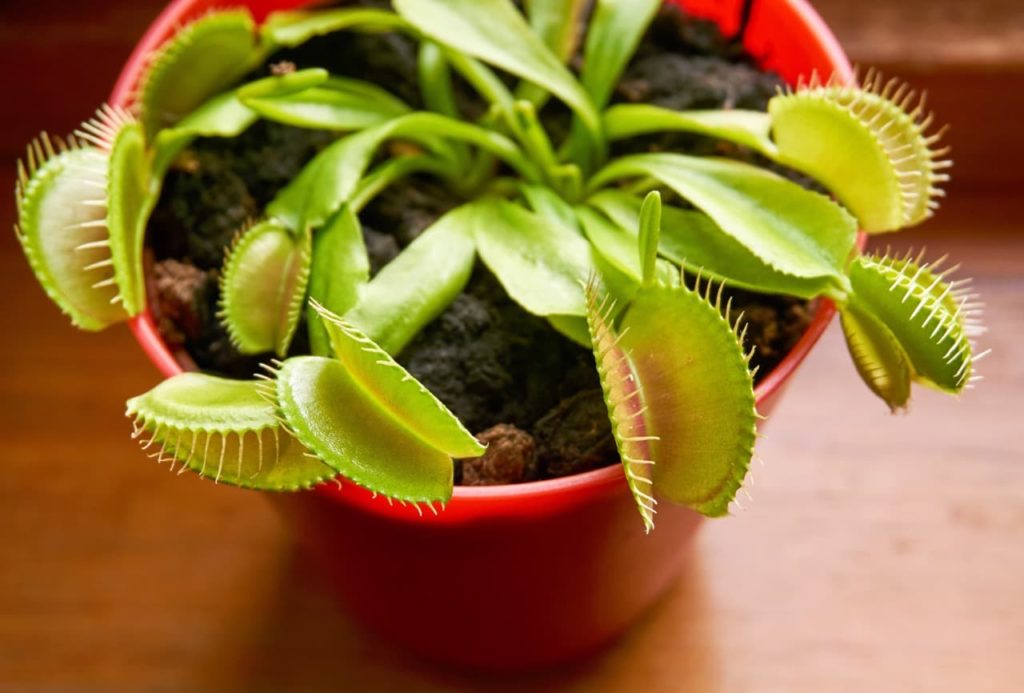
So if you have a humidifier going in the room where you may keep your Venus fly traps, this is more than ideal.
Otherwise, be sure to fine-mist them every two or three days to keep them in tip-top fly-trapping shape.
Indeed, even if these plants are kept outside during balmy weather, if you suspect that the atmosphere is on the dry side, lightly mist the plants.
It will not hurt and can only help.
If you mist, do so before noon, preferably in the mid-morning.
Container & Soil Requirements
Before we get to the nitty-gritty of watering Venus fly traps, it is important to look into the types of containers and soil you’re growing them in because, if the container or the soil is of the wrong kind, watering correctly will be of little value.
The most suitable type of pot is a circular, squat, shallow type with multiple drainage holes.
Pots made of natural stone are best for these sensitive plants.
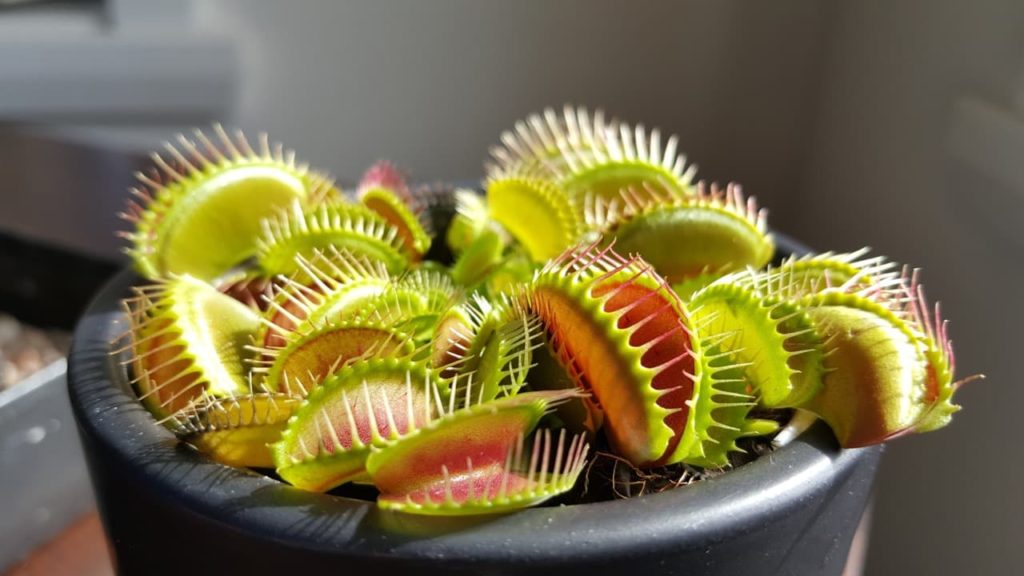
Venus fly traps thrive in soil that is damp and acidic but poor in nutrients for the obvious reason that these plants entice and grab their own food.
With this in mind, do not use potting soil or ericaceous compost for the growing medium or any type of overly-rich, fertile soil.
Procure a special potting mix for carnivorous plants made by a reputable manufacturer or make your own.
The Type Of Water To Use
The first rule of watering is that these plants require pure water: never use tap water.
Venus fly traps react poorly to the chemicals found in tap water.
“The mineral content of tap water is high enough to cause root burn, similarly to how too much chemical fertiliser can damage the roots of garden plants,” says Kevin Zhang from the Mid-Atlantic Carnivorous Plant Society.
“If you can give a carnivorous plant mineral-free water, that’s 90% of the path to success.”
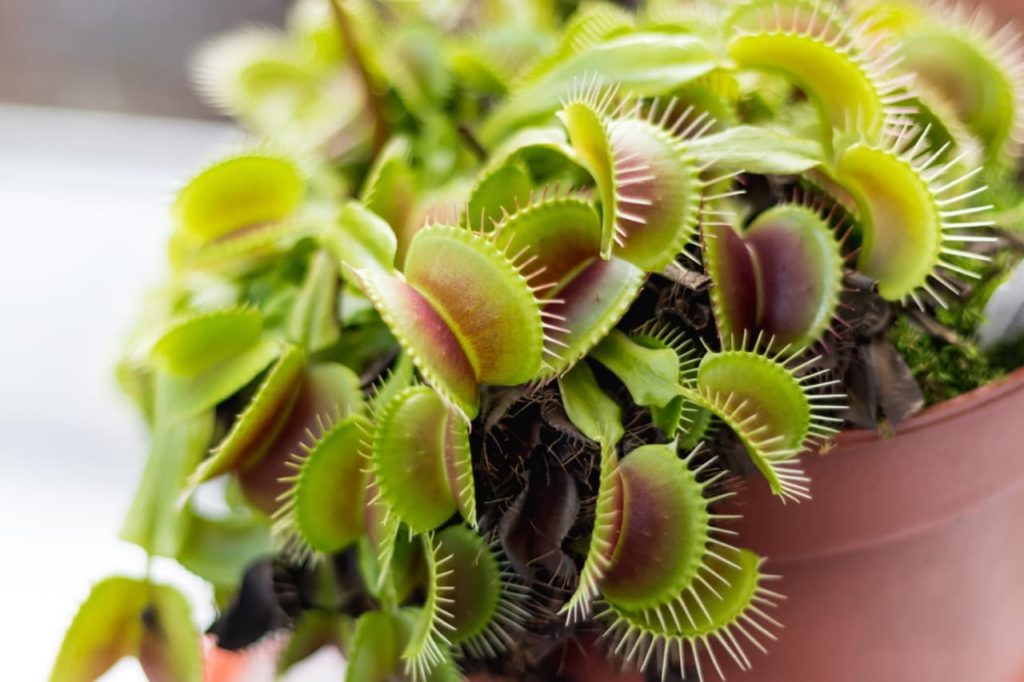
“Use a water butt connected to a down pipe to store rainwater,” says Colin Skelly, a Master Horticulturist.
“Even a small water butt will provide enough rain water for all your houseplant needs.”
The best choice is rainwater, but if that is not available, you can use distilled water.
“Keep wet with rainwater, as hard water, which flows from the taps of the majority in the UK, is poisonous to carnivorous plants,” shares Nigel Hewitt-Cooper, the owner of Hewitt-Cooper Carnivorous Plants.
“Unless your water is soft, with a Parts per million (ppm) of under 50, rainwater must be used.”
If you wish, you can always slightly acidify pH-neutral distilled water with a little hydrogen peroxide solution.
Watering Methods
The aim, except during the winter months, is to keep the medium in a continuously moist state by not letting it dry out completely.
There are two ways to accomplish this.
1) Regular Watering
The first way is by regular watering.
Use a small watering can that is fitted with a rose so that the soil is not disturbed, especially as you will be watering frequently.
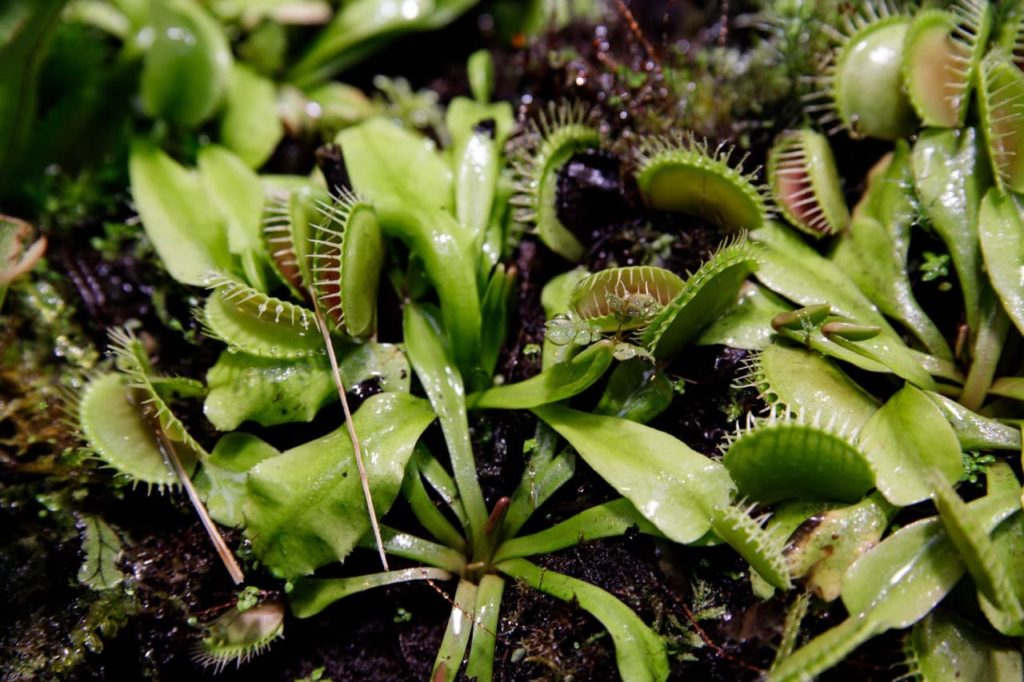
It is better to water in lower volume but to do so often than to water deeply with prolonged gaps.
How much and how often you water depends on the sun-shade mix the container is placed in and the weather.
In general, making the soil moist once every two or three days is a good plan.
However, if your container is sited in full sun and you are having a spell of hot, dry weather, you should be watering daily.
Reduce both the volume and frequency during winter but be sure to keep watering, as this is an evergreen plant and needs water year-round.
2) Bottom Watering
The second method is to place the pot in a tray of water with the water level coming up to about one-third of the way up the pot.
This style of bottom moisture somewhat replicates the boggy, marshy conditions of these plants’ native habitat.
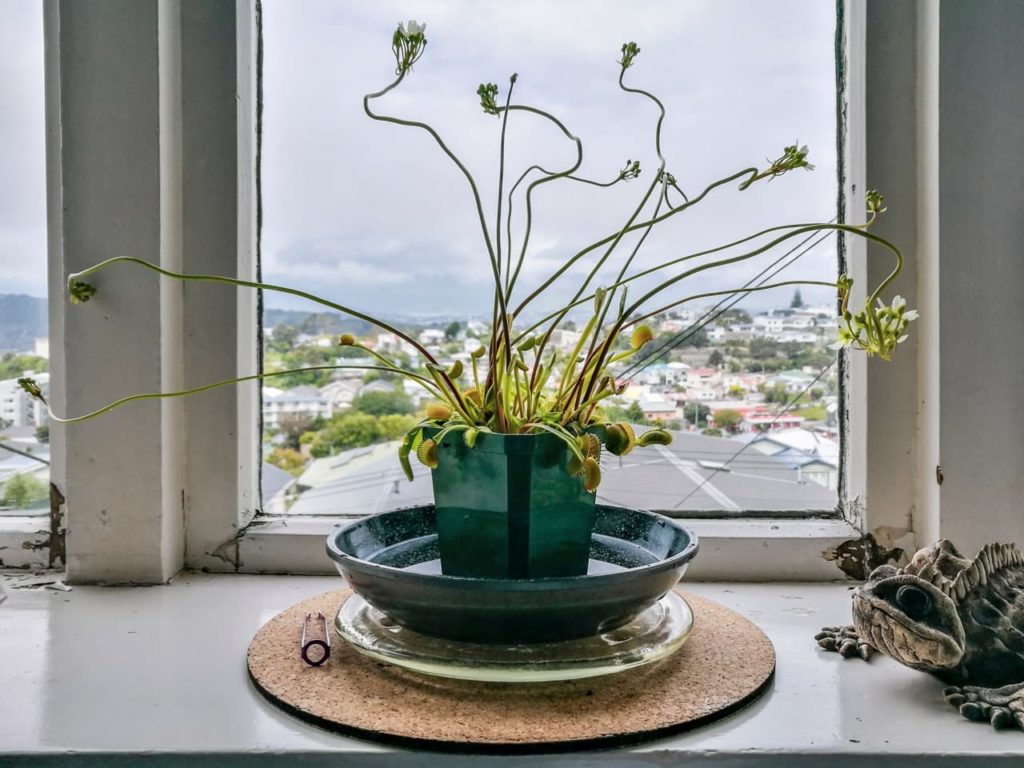
The pot must have multiple drainage holes or even side slits for this method to work.
Keep an eye on the water level of the tray and replenish it as needed and do not allow it to fall lower than a couple of centimetres.
We suggest a ‘best-of-both-worlds’ practice.
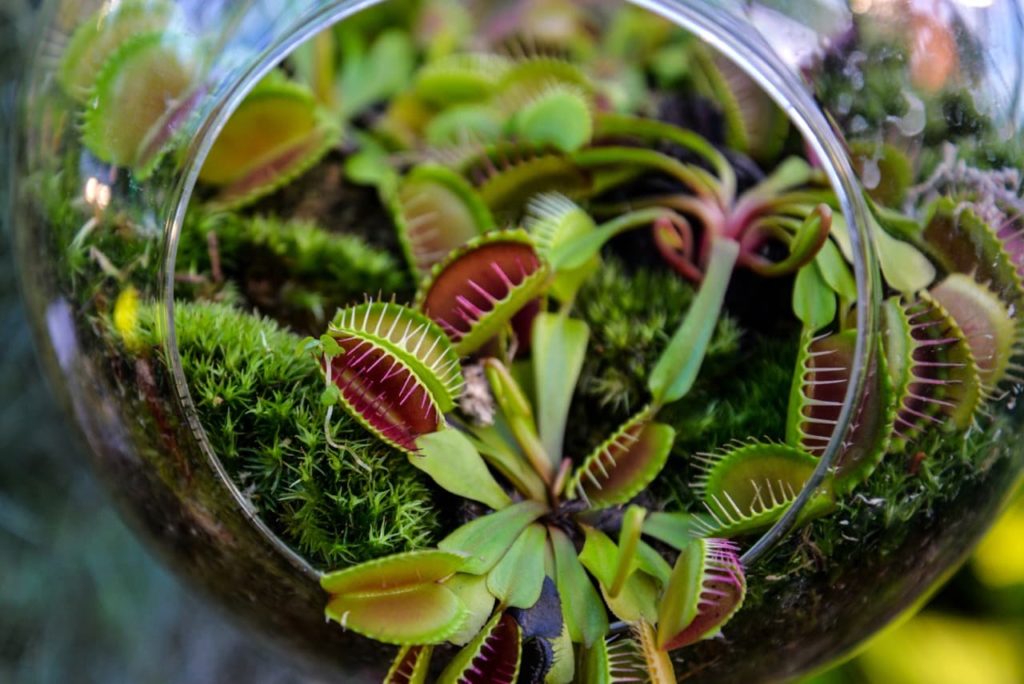
Water the plants with a watering can (as outlined above) for ten days and then place the pot in a tray for ten days, alternating between the two styles.
This type of alternation will mimic the Venus fly trap’s native habitat’s conditions even better and will suit this moisture-loving plant entirely.
References
- 1Dionaea muscipula. (n.d.). U.S. Fish & Wildlife Service. Retrieved April 20, 2023, from https://www.fws.gov/species/venus-fly-trap-dionaea-muscipula

